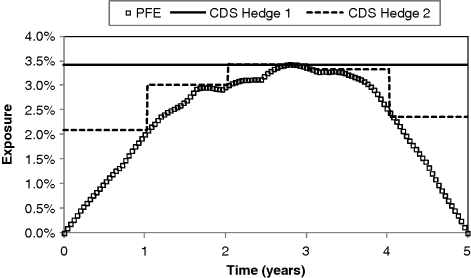16.2 Components of CVA Hedging
16.2.1 Single-name CDS
As discussed above, static hedging of a bond or similar security by buying CDS protection is a reasonable hedging strategy, albeit with many small potential risks (and technical risks such as delivery squeezes). Most fixed-rate bonds are unlikely to trade more than 5–10% away from their par value6 and hence a static hedge will, if implemented carefully, allow a major proportion of the credit risk to be eliminated.
The static hedging of derivatives exposures is much more complex due to the highly uncertain potential future exposure. As an example, we illustrate the hedging of the PFE of a swap-type exposure in Figure 16.2. The hedge notional(s) are chosen to ensure that the PFE is (over) hedged at all points in time. We consider a single CDS hedge and a term structure hedge involving five CDS instruments of different maturities. The latter hedge allows a better replication of the PFE profile.
Figure 16.2 Example of static hedging of exposure via the PFE at the 95th quantile. CDS Hedge 1 corresponds to a single-maturity instrument (5 years) whilst CDS Hedge 2 assumes a hedge involving 1-, 2-, 3-, 4- and 5-year CDS protection.

Since the static hedge is based on 95% PFE, we would expect it to be costly since it will be an over-hedge in at least 95 cases out of 100. Assuming an upwards-sloping credit curve,7 the total CVA, expressed ...
Get Counterparty Credit Risk and Credit Value Adjustment: A Continuing Challenge for Global Financial Markets, 2nd Edition now with the O’Reilly learning platform.
O’Reilly members experience books, live events, courses curated by job role, and more from O’Reilly and nearly 200 top publishers.

